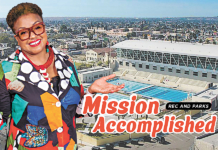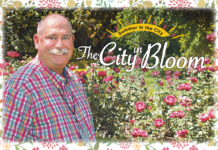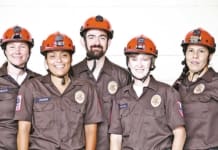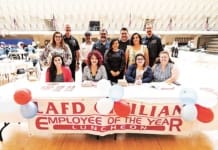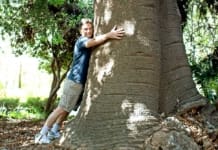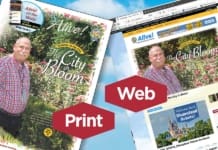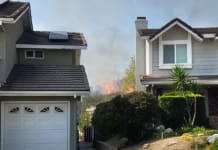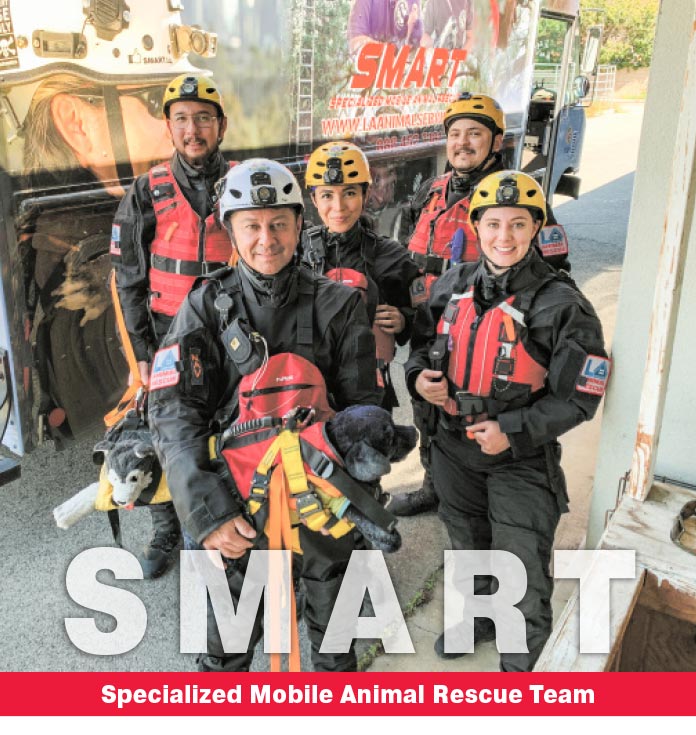
Photos by Alive!, LA Animal Services, the LAFD and courtesy Austin Gebhardt
To the Rescue
The recent rescue of a dog in the LA River brought attention to LA Animal Services’ SMART team, which teamed with the LAFD to save the pet’s life. Here’s their story.
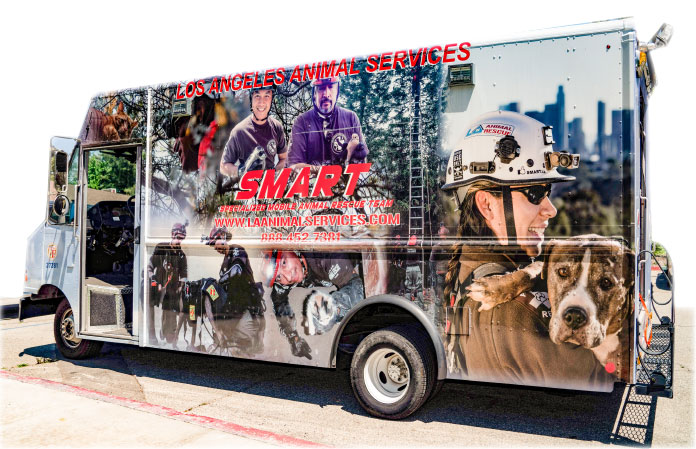
On March 28, a stormy César Chávez Day in the City, Animal Services’ Specialized Mobile Animal Rescue (SMART) Team and the LAFD’s Swift Water Rescue Team responded to a dog struggling in the fast, dangerous waters of the LA River. After a tense 30 minutes of critical actions followed by several hours of observation and medical attention for the pet, Animal Services reunited the dog – Scooby – safely with his owner. Mission accomplished!
Few people know about the day-to-day operations of the SMART team, comprised of a small number of Animal Control Officers with specialty equipment and extensive training for a myriad of rescue scenarios. The team, led by Armando Navarrete, 23 years of City service, Club Member, operates 24/7 and is headquartered at the North Valley Shelter.
Here, the team members who were involved in the rescue recount the actions of day, tell of their instant fame via the media covering the rescue, and why they do what they do.
Also, of course, the Club gives special thanks to the LAFD’s Swift Water team, led by Capt. Tom Henzgen, for their heroic work during the same rescue (the dog’s owner and a bystander were also rescued by the LAFD during the action). Well done to all.




|
About the SMART Team  In February 2012, LA Animal Services consolidated its then-Small Animal Rescue Team (SMART), Dept. Air Rescue Team (DART), Wildlife Program and Permit Section into one Special Operations Unit. The Department further unified the Small Animal Rescue Team (SMART) and Department Air Rescue Team (Large Animal Rescue Team – DART) into one join venture now called the Specialized Mobile Animal Rescue Team (SMART). This reorganization resulted in leveraging staff to do more than one function, as staff was cross-trained to support each other. The end result is more staff are available for emergency call-outs and Departmental field support. Most importantly, the Department is able to provide increased quality and improved services to the public while maximizing safety and support to the personnel. The SMART team has a 100 percent save rate since they began using their specialized training, experience and knowledge for rescuing small and large animals in distress. The Special Operations Unit, including the SMART team, is under the command of the District Supervisor Danny Pantoja and being led by Animal Control Officer Armando Navarrete. The SMART team consists of 18 LA Animal Control Officers and two Registered Veterinary Technicians. 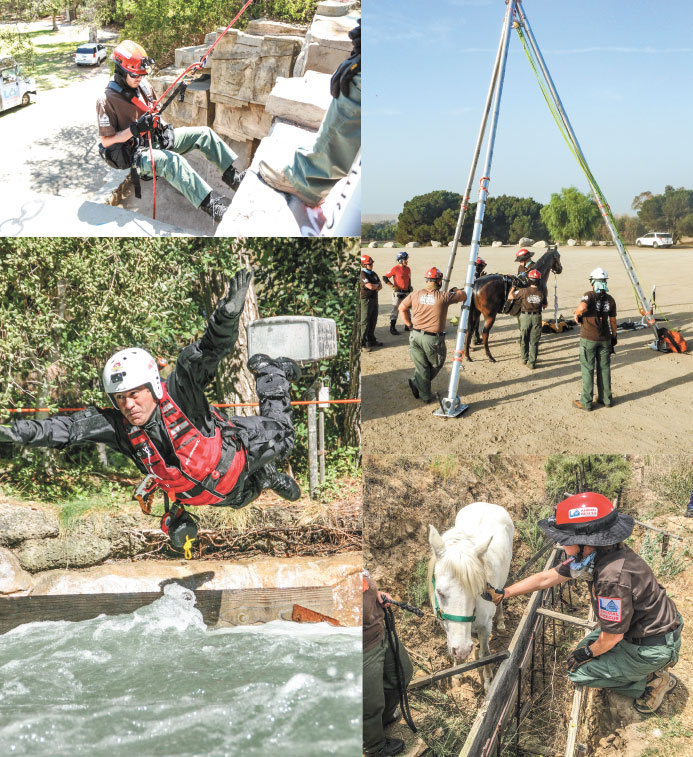 |


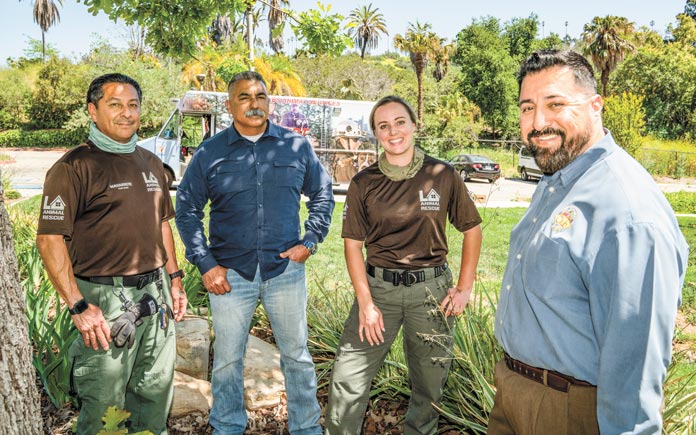
On Monday, April 4 – one week after the team helped rescue a dog from the LA River – Alive! editor John Burnes interviewed members of the LA Animal Services SMART Team who did the rescuing. They are Allyson Adriano, West LA Shelter, 2 years of City service; Armando Navarrete, North Valley Shelter, 23 years, team leader; Vanessa Flores, North Central Shelter, 2 years; Carlos Villa, West Valley Shelter, 2 years; and Tyger Rodriguez, East Valley Shelter, 5 years. All are Animal Control Officers and Club Members. SMART stands for Specialized Mobile Animal Rescue Team. The interview took place inside the West Valley Animal Shelter, with the interviewer masked due to City regulation and pandemic protocols.
Working Together to Save an Animal
Thanks for being here to tell our readers about the dog rescue you participated in.

Armando Navarrete: Sure.
This isn’t the whole SMART team, just those who helped in the rescue.
Armando: Right. We’re all on the Specialized Mobile Animal Rescue Team, SMART. We have the Swift Water Division of the Team; everyone here is part of the Swift Water Division. This is a quarter of the members we have. We have 18 on the SMART team now.
I’d like to have 24 team members by the end of next year. We just added team members. Everyone here’s been on the team for barely over six months. We started them into training right away, and they’ve already each logged about a dozen rescues of all sorts. The Swift Water Division handled the dog rescue with the LAFD last Monday.
Right. Before we get to that – how often is the team activated?
Armando: Roughly about every other day. Already today we’ve handled an animal stuck in a vent, and a cat, possibly injured, stuck in another vent. Sometimes we don’t get a call for three or four days, but then we get a call on Friday and we have three, four or five of them. And then Saturday comes and another two or three. We average a call every other day.

The Rescue
So let’s get right into it – take me back to last Monday, when it rained in LA, and you had a dog to rescue.
Armando: Tyger was the one who actually got the initial call.
Was it a busy day before you got that call?
Armando: I was off duty. I was off doing nothing but watching TV.

Vanessa Flores: It was César Chávez Day,

Tyger Rodriguez: Yes, it was. My district, which is East Valley, only had one Field Officer. It wasn’t too busy. I received a call from LA Fire Dept. Dispatch, advising me that a woman was rescued from the LA River in my district, and LA Animal Services needed to go pick up the dog. I dispatched my Officer, thinking the dog was already saved and pulled out of the river, or never fell into the river. My Officer, Endy Carballo, got there and advised me that the dog hadn’t been rescued yet. I advised the LAFD that the dog hadn’t been rescued yet and we have a team that I can dispatch. We ended up agreeing to dispatch our rescue team, and I notified our SMART Team leader Nav, which is short for Navarette. That’s when Nav texted the team, asking who was available immediately.

Allyson Adriano: Tyger sent out a text to our team. Villa and I were working here [West Valley Shelter] that day. The dog was clearly in distress. I think at that point the owner was already out of the river. As we watched it live on TV, a member of the public jumped into the water to try to save the dog. He held on for a while and then the dog got away from him. That was when we were dispatched from Nav. He sent out a text, “Who can be in the Valley in 30 minutes?” Villa and I called Officer Gabrielle Hartel, our swing Officer who lives really close to the shelter here. She was watching live, too. She came in to our shelter early so that Villa and I could head over to the river.
We jumped in Villa’s truck and we put on all our lights and everything. We don’t have sirens.
People actually pulled over for us!
When we got there, the first person we saw was Tyger. Nav and Flores were already suited up in their Swift Water gear. They had already scouted the situation.
Villa and I basically were in charge then – we had to get an animal control device, a catch pole, and nets, ropes, everything that we would need to rescue. We brought everything and ran to the scene.
By the time we got there, the Fire Dept. had already gotten the dog out of the water. But at this point it’s crucial to be able to handle the dog. That’s when we’re needed most. We have experience handling the animal that the LAFD might not have.
The dog was obviously terrified. Trying to bite, and did bite. And it was a lot of dog – 107 pounds. That’s a really hard dog to control if you don’t have that experience. So Nav and Flores went down and took over the animal handling, directing the Fire Dept. It was really great that we had both teams. The LAFD helped handle the body of the dog while Nav placed a muzzle on him.

Carlos Villa: It was a relief to see that the Fire Dept. had already gotten the dog. But there was another problem getting the dog up the embankment. We’re experienced with handling animals and it was perfect timing for us to assist with bringing the dog up.
Right. Did any of you get in the water with the LAFD?
Armando: We were going to go in the water. We were with the second team, which was downstream in case the dog bypassed the first team. We were prepared to get wet. But they got the dog ahead of us. They had him on makeshift tether leash. But at any moment he could get his spunk back and revive, and take off again.
The Fire Dept. is very well trained and has enough personnel. They had something like 20 people in the water or ready to go in the water, while we had two.
The Firefighter tried to secure the dog in a human harness, and I told the Captain, “We have these special K9 harnesses that are made for search and rescue dogs. We can put him in there and lift them like a suitcase.” The harness needs to be put on in a special way. So I told Officer Flores to put the harness on him – she had done it before – and I would control him with the muzzle. He was snapping. We got it done.
Vanessa: When the LAFD finally gained control of the dog and we had put the muzzle and harness on him, the next obstacle was to get the dog up from the bottom to higher grounds. The dog was super nervous and scared. We all worked together, which was pretty nice to see. Even though we’re from different departments, it was nice to see that we all had one purpose, one cause.
We were able to lift him up to higher grounds. At that point, Villa and Adriano and Tyger were up above to receive it.
Armando: The retaining walls are 15 feet high, and then another six feet of fencing. So that’s easily a 20-foot drop, with a very big dog.
Getting the muzzle on him was important because they can squirm and then bite. We didn’t want to lose him on the extraction going up the embankment. We’re not done until that animal is safely back to its owner in our truck.
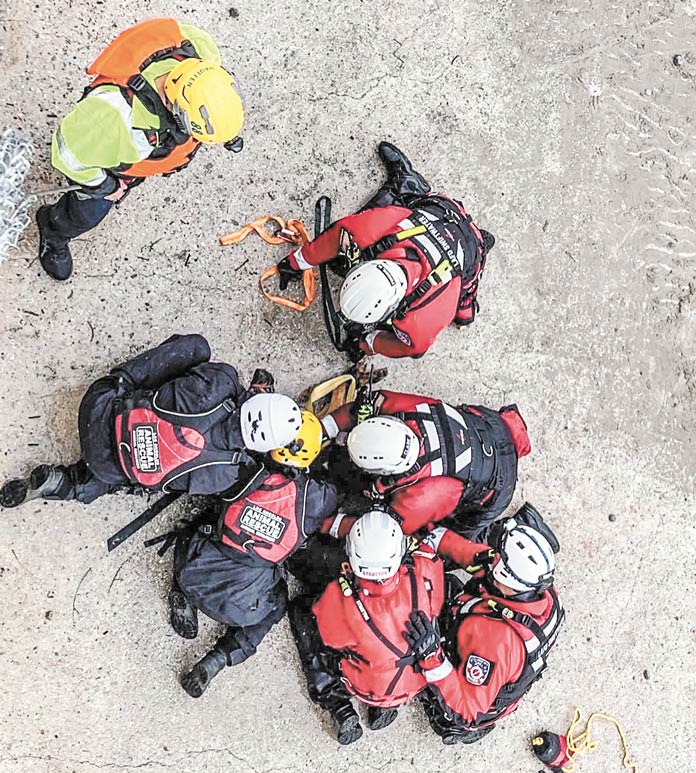
Right, of course.
Armando: It was going to start raining again, and if he got loose, he’d be going farther down river where it got deeper and deeper and flowed into rapids. We had to rescue him there and secure him safely so that we could get him up the embankment to the receiving team and then onto medical treatment.
Vanessa: I put the harness on the dog, and then he was manually pulled up the embankment by LAFD Firefighters. The LAFD took control of that, once the dog was secured and wouldn’t bite anyone at that point.
How long did it take from when you got there to the time dog was safely back in an LA Animal Services truck?
Armando: It seemed like it was only minutes. Everything happened so fast.
It was critical that my team handled our part down below and up above, and they did. Fire was great. They figured – let us do our job and we let them do their job, and it worked seamlessly. From our first minutes there to getting the dog into our truck took maybe about 30 minutes tops.
We took the dog to the East Valley Shelter for medical evaluation.
Did the dog settle down?
Carlos: Yes. He had been through a lot of stress, but he seemed calm. Maybe a little nervous. I started talking to him and petting him.
Our registered vets took a quick look at him. He got a little snappy, so we took off the harness. After that, he was completely fine.
 The Reunion
The Reunion
Did you witness the reunion with the owner?
Armando: No. But she was very happy.
Tyger: Once the dog came back to the shelter, we got in contact with the dog owner that night. We scanned it for a microchip, and after a little bit of research and a few phone calls to some microchip companies, we did located her contact information and advised her exactly where the dog was. Angela, the dog owner, came and got her dog later on that night. We waived the fees so that she could take her dog back. We wanted to get the dog back home. It didn’t need to stay in the cold kennel after being in the river. We wanted them to go back home and be comfortable together.

Armando: When we got to the river, we didn’t know who she was. Our goal was just to help the Fire Dept. with the dog rescue. Once they got him, our job was to put him in a harness and get him out safely. After we were done and we took him to the shelter for a medical examination. We were happy to hear the owner was coming to pick him up. We didn’t know the dog’s name.
The next day we got an Instagram notification because we posted it on our social media for work, and the owner responded by saying, “Thank you, thank you, thank you. He means the world to me. I was so terrified that he was going to float downriver and die. They got me out, but I had to go to the hospital and I didn’t know what was going on. I was watching the news, and when I saw that you guys actually got him up and out, it was just a sigh of relief. I just felt like my baby’s coming home.”
We reunite a lot of family members after a traumatic situation like that. It was just nice that she thanked us. We don’t do it for the thank yous or the fame or the money, but it’s nice when someone says thanks. We finally got to meet her, and Scooby – that’s his name, Scooby – is back to being his normal self like it never happened.
 A Big Moment
A Big Moment
Was this your first major incident after you were trained for this sort of work?
Carlos: Definitely the biggest – the LAFD was involved, the media was involved, there were so many people around. It was definitely the first time for something that big, at least for me. There were at least four helicopters – it was just a little bit nerve wracking. There were so many people watching and I was trying to focus on getting the dog safe.
But we’ve been responding nearly every day since we did our training. We are trained to handle these situations. It was just the whole scene and the circumstances of the rescue that made it a little different.
Vanessa: This was my first big water rescue. It doesn’t rain very often around here, right? It just so happened that it rained a lot. We were trained for it.
The whole scenario was very new. It was very chaotic, very hectic. You have to zone everything out and just focus on what we were trained to do, and forget it, right. We were trained properly. It was a great experience.
Tyger: It definitely wasn’t the first big rescue that we’ve had. I consider every rescue that we do big because you’re saving a life. But it was the largest in scale, just based on people involved – boots on the ground, news coverage and citizens standing by. That plays a role in how you approach the scene because the more eyes on you, you can feel that weight and that pressure of people watching you. Luckily, we’ve had some pretty intense training. It wasn’t anything we couldn’t handle.


The Spotlight
That was a pretty intense day. Lots of media coverage from throughout the world. Were you prepared for the notoriety?
Allyson: Well, I wasn’t in front in the camera, really. I was in the back, but my parents actually did notice. Usually I call them on my way home but this was two hours after it happened. They hadn’t heard from me, and they saw me on the news. They said, “Oh, my gosh.” I did get a call from them right way, from my best friend, other Officers, you know, everybody. My phone was just completely blowing up. Everyone was so excited and asking, “Were you guys there?” Obviously they know about our team.
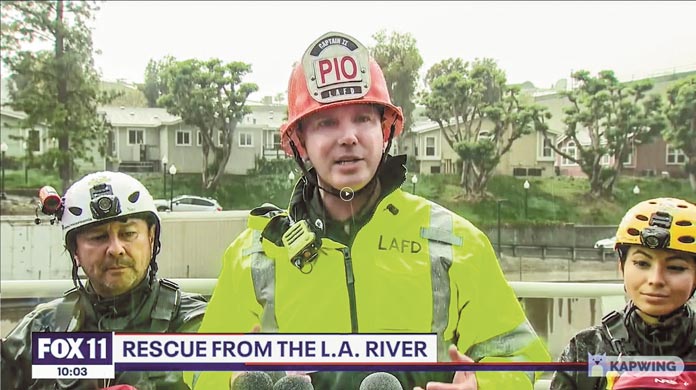
Right.
Allyson: We talk about it. It’s a highlight of our job, when it happens.
Vanessa: My brother called me. My mom saw it on the news. It’s something new, right? When am I ever on TV? Never. It was kind of awkward at first, but at the same time it’s nice that my family’s proud of it. My friends are proud of it. It’s nice to be a part of this team. I’m proud of what we do. We make a lot of animal owners happy, right? Not just anyone is willing to do these things for animals. It’s nice that we can be a part of something so special.
Carlos: Last Friday [four days after the rescue], I was driving down the street comparing gas prices, because it’s been so expensive. I park at one and I’m pumping gas. This car pulls in front of me – I’m not even paying attention and this girl comes up to me and says, “Oh, my God. Carlos.” I looked up and it was a friend from high school friend. I hadn’t seen her in eight years. She says, “How are you doing? I’ve seen what you’re doing!” She says, “I’m so happy for you. What you’re doing is so cool.” It was just so random and it made me realize that we do have a pretty cool job. Not everybody gets to do what we do, and it’s pretty awesome.
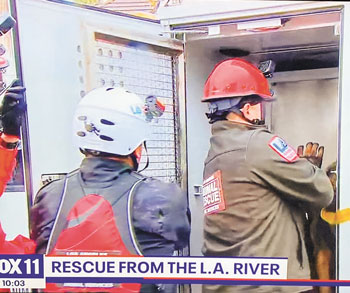
Tyger: Once we were done with the rescue and heading back to the shelter, there was already, like, 30 text messages in our team group chat – work texts from all the Officers who are on the SMART team saying, “Hey, good job, guys. You guys are great. You guys look professional. You guys knew what you were doing.”
And outside of that, I’m getting text messages from my wife saying, “I saw you on TV.” My mom’s calling me mid-rescue and I’m ignoring the calls. We got some photos from our team members from the news broadcast that was live and they posted that on the group chat as well, saying, like, “Look how good you guys look. Way to command the dog.” Things like that.
And I took it upon myself to share on my social media some of the photos. “Hey, look. I had fun today at work. Look at what we did.” Within 24 hours, there was like 100 comments like, “Oh, my God. I saw you. Good job. Thank God that the dog is safe.” I didn’t think it was going to get that sort of recognition because normally I might get four or five comments. It goes to show the meaning of what we do and why we do it. It’s definitely nice to be reminded. That can get lost over time. You don’t join the team to expect that reaction, but when it comes out of the blue like it did, it hits you and gives you like a radiating glow based on all the appreciation from people who weren’t even involved. So it’s kind of special to see that you have that kind of impact on the world just from one rescue.
Once the dog was brought up to the second level embankment where we were all on dry land, I reached for the dog and we started to walk. And once Flores came up the ladder, I was controlling the dog and we were walking back to the rescue vehicle. Something like 100 people surrounded us, and they all just started breaking out in cheers, clapping and celebrating that the dog was safe. And that kind of– Although you don’t try to buy into it, like I said, that’s not why you do it–
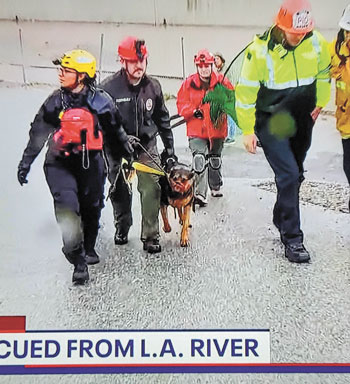
Right.
Tyger: It kind of just gives you a warm fuzzy feeling inside, a breath of fresh air.
It’s nice every once in a while to be reminded of the power of what you do.
Tyger: Exactly.
Your emergencies haven’t stopped. [In the middle of this interview, Allyson had to leave for an emergency call.] They just keep going on and on. There are no cameras or helicopters on most of what you do, yet you always respond.
Tyger: Right.
Thanks, everybody for speaking to us today, and congratulations on a great rescue.
Armando: Thank you!
|
BEHIND THE SCENES
|


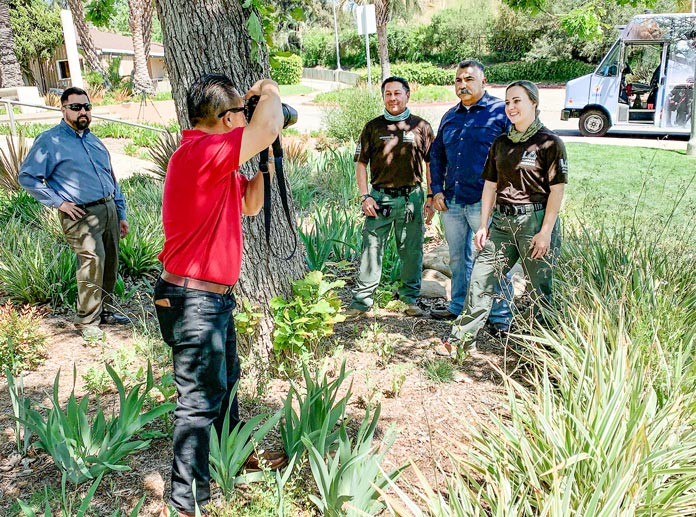 Club Director of Marketing Summy Lam (foreground) photographs members of the Animal Services’ SMART Rescue Team (from left): Animal Control Officer Armando Navarrete, Club Member; Animal Services District Supervisor Danny Pantoja, Club Member; and Animal Control Officer Alyssa Adriano, Club Member. Watching at left is Club CEO Robert Larios.
Club Director of Marketing Summy Lam (foreground) photographs members of the Animal Services’ SMART Rescue Team (from left): Animal Control Officer Armando Navarrete, Club Member; Animal Services District Supervisor Danny Pantoja, Club Member; and Animal Control Officer Alyssa Adriano, Club Member. Watching at left is Club CEO Robert Larios.
